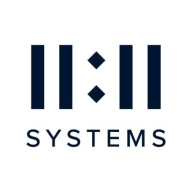

Find out in this report how the two Cloud Backup solutions compare in terms of features, pricing, service and support, easy of deployment, and ROI.

11:11 Cloud Backup is designed for businesses needing reliable data protection and secure storage. It offers scalable and efficient cloud backup solutions, tailored to meet diverse business needs.
11:11 Cloud Backup ensures data protection with a robust and flexible system. It stands out with its capability to handle large-scale data operations effectively, providing peace of mind for data security. Users benefit from easy data restoration, ensuring minimal downtime during data loss scenarios. The intuitive management interface promotes efficient data oversight, enhancing the data backup experience. As user demands grow, 11:11 Cloud Backup allows scalable upgrades for enduring data requirements. Users can improve their backup routines with strong encryption methods, safeguarding data integrity.
What are the essential features of 11:11 Cloud Backup?11:11 Cloud Backup implementation varies across industries, offering tailored data protection solutions. In finance sectors, it supports compliance through secure data retention. Healthcare organizations benefit from rapid data access and recovery. Retail businesses rely on its robust encryption to protect customer information.
NetApp Cloud Backup is a fully integrated service for cloud backup and restoration. It was created to comply fully with NetApp's native data management software ONTAP, used for hybrid cloud experience. NetApp Cloud Backup is used to create backup and restoration for the protection and archiving of data, databases, and virtual machines related to the Cloud and On-Premises data in ONTAP. The way NetApp Cloud Backup works is by automatically creating block-level incremental backups. This ensures that the created backups are very fast and easy to restore. It is suitable for data protection regarding on-premises software as well as in the public cloud. NetApp Cloud Backup provides users with the ability to protect their cloud data at affordable prices and with a user-friendly interface so they don't need a lot of technical knowledge to be able to secure their cloud storage.
The copies created by NetApp Cloud Backup can be stored in the user's personal object storage in the cloud as well as on premises with StorageGRID - NetApp's storage platform. The backup copies can be restored to the original source or to a different source in Cloud Volumes ONTAP. NetApp Cloud Backup provides backups to AWS, Azure, and Google Cloud.
The features NetApp Cloud Backup provides include:
In addition to enhanced security and protection from malicious attacks, the advantages of using NetApp Cloud Backup include:
Abbasi P., a User at a financial services firm, likes that NetApp Cloud Backup is a completely agentless solution.
A Service Manager at a tech services company values its stability, scalability, and good technical support.
We monitor all Cloud Backup reviews to prevent fraudulent reviews and keep review quality high. We do not post reviews by company employees or direct competitors. We validate each review for authenticity via cross-reference with LinkedIn, and personal follow-up with the reviewer when necessary.